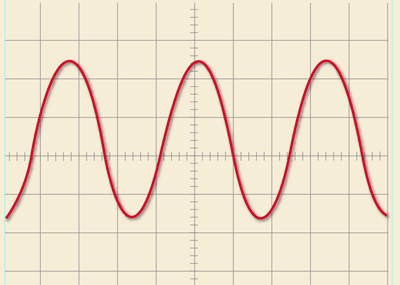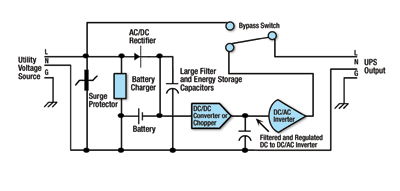Generators + UPSs: match or bridge to nowhere?
Choosing the right UPS topology holds the key to clean generator backup
BY PAUL NEWMAN
Falcon Electric
Irwindale, CA
http://www.falconups.com
The continued acceleration of the Internet has been accompanied by an equally large demand for high-quality power to feed the Internet infrastructure. Internet power consumption continues to increase in the magnitude of hundreds of megawatts or more per week, taxing the already stressed electrical grid. Requiring a continuous source of high-quality uninterrupted power, critical Internet infrastructures must rely on internal power quality protection systems. The caliber of the power quality system protecting critical computing operations is a defining factor for users who now feel the effects of power-related problems often in millions of dollars per incident, as well as an incalculable loss of reputation for a business based on being on-line 24/7.
Voice-over-IP (VoIP), e-commerce, mobile, and e-mail communications are just a few of the Internet-based technologies that demand clean, uninterrupted power. Today, power quality is the number-one issue affecting Internet and communications reliability.
The engineering community is continually faced with the task of selecting the correct power system topology. This can be even more challenging when a generator comes into the mix. For larger centralized three-phase UPS systems, working with an engine generator is usually straightforward. However, when it comes to smaller single-phase UPS systems, generator compatibility can be a challenge. By evaluating popular power system topologies from the standpoint of generator capability, one can determine which topology can best fulfill the needs of today’s 7 x 24 x 365 “always-on” world.
To ensure critical customer and data interfaces remain viable, businesses now have to review and properly address backup power requirements for their entire data and telecommunications infrastructure. In order to combat the exposure to blackouts, businesses large and small have deployed millions of “office-grade” line-interactive uninterruptible power systems (UPS), which have proven to be a relatively low-cost solution.
The requirement for longer runtime has led to a rise in applications where several extended battery packs or an over-sized UPS is specified. This gives the user extended time of available IT and communications resources to keep their business operations humming during a prolonged power outage. However, adding batteries for extended run times can become cumbersome and expensive since the average lifespan of a battery is typically 18 to 24 months. This shortened battery life is due to excessive cycling, as the batteries are used frequently as part of the boost-buck automatic voltage regulation (AVR) feature in these units. This AVR feature is often used several times a day to mitigate sags and brownouts. The expense to replace batteries is now several hundred dollars. This is the point where small generators look very attractive.
Small generators and extended runtimes
Small backup generators are a practical solution for providing business processes, military operations and rural computing and communications services with extended periods of backup power. However, this solution presents a major problem, since the UPS now has to act as a bridge between the instant the blackout occurs and the minutes that transpire while the generator is turned on and comes online. To test this new extended runtime power system, the user will perform a dry run and unplug the UPS from the wall (which is NOT recommended) then plug the UPS into the generator, only to discover that the UPS stays on battery and will not convert the raw generator power into computer-grade power. The UPS keeps beeping, stays on battery, and eventually drops the load.

Fig. 1. Gas, diesel, or other inexpensive generator sources produce an output waveform that is very harsh due to wide voltage changes, frequency changes, and brush-induced noise.
To ensure the continuous operation of critical equipment and eliminate this problem during the generator startup, an industrial grade on-line UPS must be installed. This will ensure a secondary source of power to all of the equipment that makes up the data and telecommunications infrastructure. Industrial-grade on-line UPSs are of higher quality than office-grade line-interactive or on-line UPSs. These units typically can operate in higher-temperature environments and are built to tolerate dirty power (see Fig. 1 ) under harsher than usual conditions, making them well suited for handling shifting frequencies from generator power.
The double-conversion on-line UPS
A high-quality double-conversion on-line UPS is the best solution, as it continuously regenerates new, clean sine-wave power (see Fig. 2 ). Sensitive computer and communications equipment will always receive stable power, devoid of voltage and frequency problems. When selecting an on-line UPS, low-cost products should be avoided. Only a high-quality double-conversion on-line UPS can guarantee generator compatibility and provide maximum battery life. The double-conversion on-line UPS will also accept extended battery modules that can provide hours of backup.

Fig. 2. Clean computer-grade power is free of all transients, noise, and frequency shifts.
Besides generator compatibility, a major advantage of the on-line UPS (see Fig. 3 ) is its ability to provide an electronic firewall between the incoming utility power and sensitive electronic equipment. While the off-line and line-interactive designs leave equipment connected directly to the utility power with minimal surge protection, the on-line UPS provides multiple electronic layers of protection from power problems on a continuous basis. This is accomplished inside the UPS in several tiers of circuits.

Fig 3. Typical on-line UPS design topology.
First, the incoming ac utility voltage is passed through the MOV surge protected rectifier stage where it is converted to a dc, which is heavily filtered by large electrolytic capacitors. This removes line noise, high-voltage transients, harmonic distortion, and all frequency-related problems unlike off-line and line-interactive designs. The input capacitors also act as an energy storage reservoir giving the UPS the ability to “ride-through” momentary power interruptions without battery drain. As the battery source is also connected to this dc circuitry, it simply takes over as the energy source in the event of a complete utility loss. This makes the transition between utility and battery power seamless, without the 4 to 25-ms interruption in the UPS output associated with the other two UPS topologies.
The filtered dc is sent to a dc/dc converter or chopper circuit that acts as a dc voltage regulator. The dc voltage is tightly regulated and fed to a second set of filter capacitors. This stage gives the UPS its ability to sustain a constant output even during sustained deep brownouts or low-line conditions, which would require the off-line or line-interactive UPS to go to battery mode. Some on-line models on the market will accept a drop in utility line voltage below 80 V, while maintaining an output voltage of 120 Vac ±2%.
The regulated dc voltage is fed to a 100% duty-cycle PWM inverter where, in most designs, a totally new 50/60-Hz true ac sine-wave output power is generated. As on-line UPS inverters have to provide output power 100% of the time, they are the most robust and tested designs in the industry. These rugged PWM inverters provide totally new, clean, true sine-wave power. They deliver superior ac output voltage regulation (2% typ), having a frequency regulation of 0.1% typ.
Not all UPS units on the market are compatible with generator power sources. Low-cost office-grade on-line, line-interactive, and off-line designs should be avoided due to the following reasons:
UPS will continuously stay on battery mode when operating from a generator source, rendering them useless.Increases cost of ownership due to a decreased battery life. If installed in locations with power quality problems, the battery life is greatly decreased due to the UPS having to continuously transfer to battery mode to perform voltage regulation functions.Limited battery runtime and undue amount of batteries recycled or introduced to landfill, if batteries are not disposed of properly.
An industrial-grade on-line UPS will have a greater tolerance for the shifting frequencies and overall dirty power that comes from a generator. In this way, the UPS gives users both instantaneous power when the power fails and the compatibility to work with an auxiliary generator that is configured with a manual transfer relay or an automatic transfer switch (ATS) so the user can simply flip a switch and have a true long term and high-quality solution to power outages. ■
For more on UPSs, visit http://www2.electronicproducts.com/Power.aspx.
Advertisement
Learn more about Falcon Electric





